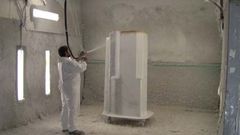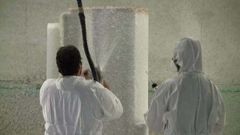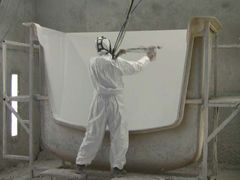Styrene
What is Styrene
Styrene is the monomer (polyester resin) used in the production of polystyrene by a free radical polymerisation process usually initiated by a Methyl Ethyl Keytone Peroxide (MEKP). Polystyrene is a used to form moulded plastic materials in the construction, and manufacturing industries.
What are the Effects of Styrene Exposure
The potential for exposure principally appears to be styrene and volatile organic compounds through inhalation, either during the primary process or secondary processes from cleaning or residue from clothes and equipment. Styrene exposure is an irritant which may affect eyes, mucous membranes and have gastrointestinal effects. Long term health effects may affect the central nervous system which may include symptoms of nausea, fatigue and depression.
What is the Exposure Standard for Styrene
The NSW Work Health and Safety Regulation 2011 (WHS Reg) prescribe specific duties in relation to exposure standards for specific chemicals and mixtures at Chapter 3, Part 3.2 Division 7 Managing risks from airborne contaminants. WHS Regulation 49 requires a Person Conducting a Business or Undertaking (PCBU) at a workplace to ensure that the airborne concentration of a styrene does not exceed the exposure standard. WHS Regulation 50 requires that atmospheric testing is carried out to confirm the compliance with the exposure standard for styrene
The exposure standard refers to the publication by Work Safe Australia “Workplace Exposure Standard for Airborne Contaminants” with the Date of Effect being 22 December 2011. The exposure standard for styrene monomer is a Time Weighted Average (TWA) of 50 Parts Per Million (ppm) with a Short Term Exposure Limit (STEL) of 100 ppm.
The derivation of the TWA at 50 ppm appears to be the most suitable to prevent pre narcotic effects and a STEL of 100 ppm to prevent narcotic effects and nose and eye irritation. On the weight of evidence, neurobehavioral, opthatoxic and carcinogenic effects do not appear to be justified to limit exposure levels below 50 ppm.
Biological sampling of urine at the end of the working week and measuring mandelic acid and phenylgloxylic acid can be taken to assess the efficacy of Respiratory Protective Equipment (RPE). Biological results should not exceed 1000 mg/g creatinine to account for increased uptake during strenuous work which affects the uptake of styrene through the respiratory system.
How can Atmospheric Air Monitoring for Styrene be Conducted
The measurement and sampling of styrene levels should be undertaken by the pumped sampling method to AS 2986.1-2003 Workplace air quality –Sampling and analysis of volatile organic compounds by solvent desorption/gas chromatography Part 1: Pumped sampling method provides an overall precision and bias of approximately 5 – 10 % when undertaking airborne styrene monitoring using a charcoal tube. The sampling train should include a single adjustable low flow tube holder with a Type A protective tube cover with a flow rate of approximately 50 ml/min by a calibrated rotameter.
Colourimetric gas detection tubes may be used to assess potential styrene air levels during specific tasks; however it should be understood that Relative Standard Deviation (RSD) may be ±15% and cannot be used to determine the overall styrene levels over an entire shift. Other challenges with colourimetric gas detector tubes includes cross sensitivity with other chemicals including methyl alcohol, ethyl alcohol, ethyl acetate, butyl acetate, butadiene, formaldehyde, acetaldehyde and acryonitrile which may affect the measurement.




